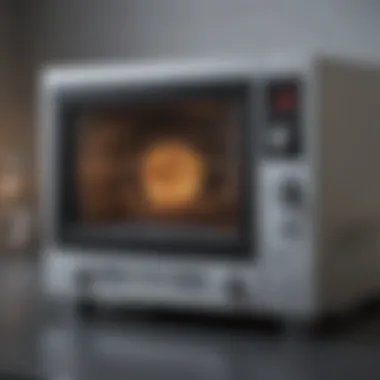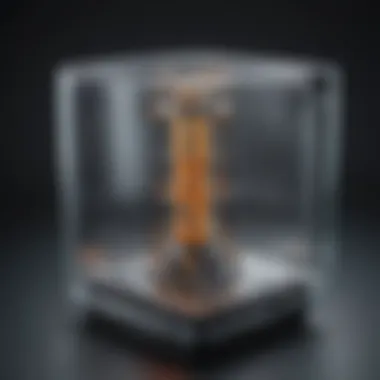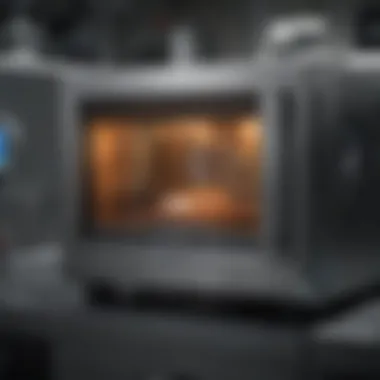Understanding Microwave Circulators: Principles & Uses


Intro
Microwave circulators are essential components in the field of microwave engineering. Their importance stems from their role in ensuring efficient signal routing within various systems. Understanding the principles that govern their operation is crucial for those involved in telecommunications and radar technology. In this section, we will explore the fundamental aspects of these devices, examining how they function and why they are integral to modern communication systems.
The basic function of a microwave circulator is to control the direction of signal flow. This capability is vital in preventing signal interference and losses. Circulators are typically found in applications such as satellite communications, wireless networks, and radar systems. By directing signals in a specific order, they pave the way for smooth operations within these technologies.
As we delve deeper into this subject, we will outline the principles and mechanisms that underpin microwave circulators. Furthermore, we will discuss their design and how various characteristics influence their effectiveness in practical applications. The overarching goal is to provide a comprehensive overview that is beneficial for students, researchers, and industry professionals alike.
Prelims to Microwave Circulators
In the field of microwave engineering, the concept of circulators plays a crucial role. They are pivotal components, particularly in systems that demand efficient signal routing without sacrificing performance. Understanding microwave circulators is more than an academic exercise; it ensures that students, researchers, educators, and professionals grasp the integral functions of these devices in telecommunications, radar systems, and beyond.
A microwave circulator is designed to control the flow of microwave signals between three or more ports. This functionality is significant in minimizing signal loss and improving overall system efficiency. The unique properties allow microwave signals to circulate in one direction only, effectively isolating different circuits. This non-reciprocal behavior is essential for certain applications where signal integrity must be preserved across multiple paths.
Additionally, discussing microwave circulators also aids in recognizing their historical advancements. These devices have evolved in tandem with the demands of modern technology, adapting to an ever-changing landscape of communication needs. The understanding of their development gives context to current applications and future potential.
As we explore this topic, it is critical to appreciate not only how microwave circulators function but also their implications in real-world applications. This section sets the foundation for a deeper examination into the principles of operation and the diversity of designs that characterize microwave circulators.
Definition and Functionality
Microwave circulators are specialized active devices that facilitate the transfer of electromagnetic signals in a predetermined direction. Their primary function is to route signals between different ports, ensuring that they travel in one direction only. This property is valuable for maintaining the performance integrity of complex systems, where signal interaction may lead to interference or degradation.
Key functionalities include:
- Isolation: Circulators prevent feedback by directing signals away from sensitive equipment.
- Power Handling: Designed to manage high power levels without distortion or loss.
- Versatility: Applicable in various settings, including telecommunications, radar, and medical imaging.
The basic operating principle relies on magnetic materials, primarily ferrites, which change their characteristics based on the magnetic field applied. This interaction allows for efficient routing and minimizes losses, making circulators a preferred choice in many applications.
Historical Development
The evolution of microwave circulators has been closely linked to advancements in microwave technology and the growing need for high-performance communication systems. These devices began to emerge prominently in the mid-20th century, aligned with the development of radar technology during World War II.
Early designs utilized bulky and inefficient materials. Over time, as research progressed, significant improvements emerged in material sciences and engineering techniques. Key milestones in their development include:
- The introduction of ferrite materials improved signal handling capacity.
- The compact design of circulators has enabled integration into various devices, enhancing versatility.
- Innovations in fabrication techniques have allowed for greater precision and reliability in performance.
With ongoing research, the future of microwave circulators looks promising. Emerging technologies are likely to introduce even more efficient designs, responding to modern challenges in telecommunications and other fields. Understanding the historical context provides insight into their significance and informs future developments.
Fundamental Principles of Operation
The section on Fundamental Principles of Operation is crucial in understanding how microwave circulators function. This knowledge lays the groundwork for appreciating their role in various applications, including telecommunications and radar systems. By grasping the basic physics and theories behind their operation, one can delve deeper into design considerations and technological advancements. The operation of circulators is based on physical principles that dictate how electromagnetic waves interact within these devices, which in turn influences their efficiency and performance in real-world applications.
Basic Physics of Circulation
Microwave circulators rely on the principles of electromagnetic wave propagation and the behavior of materials under external influences. The basic physics involves the interaction of waves with magnetic fields. Typically, a microwave circulator contains ferrite material, which exhibits a change in its electromagnetic properties when subjected to a magnetic field. This property is essential for creating a non-reciprocal path for the waves, meaning that signals can flow in a specific direction without reflecting back.
One key aspect of this phenomenon is the Faraday effect, which describes the rotation of the polarization plane of light passing through a magnetic material. In circulators, as microwave signals enter, the ferrite rotates the polarization, allowing the signal to direct itself through the output port while preventing backflow. This characteristic is what enables typical applications, such as isolating certain signal paths in complex circuits.
The efficiency and performance of a circulator depend on several factors, including temperature, the intensity of the magnetic field, and material properties. Understanding these basic physics principles is fundamental for designers faced with the challenge of maximizing performance in microwave devices.


Reflection and Transmission Theory
Reflection and transmission theory underpins how microwave circulators handle incoming signals. This theory focuses on the behavior of waves when they encounter different media. In the context of circulators, it is vital to analyze how the signals are transmitted through various ports and how they are affected by reflections.
When a microwave signal enters a circulator, it encounters multiple interfaces within the device. The guiding principle here is that reflections can occur when signals hit these interfaces unless adequately managed. The circulator is designed to ensure that the majority of input signal transmits to the desired output while minimizing any unwanted reflections back into the system. This is critical for maintaining signal integrity in high-frequency applications.
Several factors influence reflection and transmission within these devices:
- Impedance Matching: Ensuring that the impedance of different components matches to minimize reflections.
- Frequency Response: The device's ability to effectively handle a range of frequencies without significant signal loss.
- Loss Mechanisms: Understanding various losses, such as dielectric and conductor losses, which can affect performance.
In practical applications, understanding reflection and transmission theory leads to better designs for microwave circulators that can efficiently route signals and reduce interference.
"The fundamental principles of operation serve as the backbone of microwave circulators, influencing their application in telecommunications and beyond."
By comprehending these principles, engineers and researchers can explore innovative designs and applications that push the boundaries of existing technologies.
Types of Microwave Circulators
Microwave circulators play an essential role in the management of microwave signal paths in various applications. Understanding the different types enhances effective decision-making in design and implementation. Each type of circulator serves distinct needs, influencing performance and functionality significantly. Below, we examine three primary categories of microwave circulators: ferrite circulators, non-reciprocal devices, and optical circulators. Their unique characteristics and applications are crucial for anyone working in telecommunications and other fields requiring microwave technology.
Ferrite Circulators
Ferrite circulators represent one of the most common types used in microwave systems. These devices utilize ferrite materials, which exhibit non-reciprocal properties under the influence of a magnetic field. The fundamental operation of ferrite circulators relies on the electron spin resonance phenomena found in ferrite materials.
This circulation is critical in applications like radar and communication systems, where signal routing is essential. Ferrite circulators can handle high power with minimal loss, making them suitable for various frequency ranges.
Compared to other technologies, ferrite circulators are praised for their robustness and reliability. They typically consist of three ports, allowing signals to enter from one port and exit through another while preventing reflections back through their input. Their ability to manage high-frequency signals adds to their utility in modern electronic equipment.
Non-Reciprocal Devices
Non-reciprocal devices form another essential class of circulators. Unlike traditional passive devices, non-reciprocal devices are designed to control signal flow directionally without allowing signals to return. This characteristic is crucial for applications requiring isolation between network components.
The functionality of non-reciprocal devices is commonly achieved through the integration of various materials and configurations. They can be employed in communication systems where isolation is necessary to prevent feedback interference. By ensuring that signals pass through one direction only, these devices enhance overall system stability and performance.
Optical Circulators
Optical circulators are a more recent innovation that extends the principles of microwave circulators into the optical domain. These devices manage light signals similarly to how microwave circulators manage electromagnetic signals. Employing advanced materials and design techniques, optical circulators handle data transmission in fiber optic systems effectively.
The significance of optical circulators lies in their ability to increase bandwidth and manage signals efficiently. With the rapid expansion of optical networks, their role in telecommunications and data centers becomes increasingly critical. They provide a compact and effective solution for routing signals, making them valuable in modern communication infrastructure.
Optical circulators represent the next frontier in signal management, bridging the gap between electromagnetic and optical applications.
In summary, understanding these types of microwave circulators enriches our perspective on their contributions to microwave technology and its applications across diverse fields. Proper selection and application of these circulators enhance the effectiveness of communication systems, radar, and even emerging technologies.
Design Considerations
Design considerations are crucial when developing microwave circulators. They influence the performance, efficiency, and applicability of these devices in various fields. Specifically, the material selection, geometrical configuration, and frequency range and power handling capabilities should align with the intended use of the circulator. A careful analysis in these areas can lead to significant performance enhancements and operational reliability.
Material Selection


The choice of materials in microwave circulators affects their durability and transmitting capabilities. Ferrite materials are often used for their unique properties. They exhibit non-reciprocal characteristics, essential for effective circulation of microwave signals.
Other materials like ceramics and metals can also play a role, depending on the application requirements. For instance, ceramics can offer high dielectric strengths, making them suitable for high-frequency applications. The selection must take into account the environmental conditions, such as temperature and humidity, as these factors can influence material behavior over time. Always consider components' dielectric properties, thermal stability, and mechanical strength.
Geometrical Configuration
Geometrical configuration is equally important. The layout and design of the circulator must facilitate optimal signal flow. This includes the size and shape of the ferrite core and the arrangement of ports.
For example, a typical design might feature a tri-port configuration, which allows fluid signal transmission in a single direction. Adjusting dimensions can help mitigate losses and enhance efficiency. It also determines the device's suitability for specific applications, like telecommunications or radar systems. Using simulation tools may help visualize potential improvements in geometrical layout before fabrication.
Frequency Range and Power Handling
Frequency range and power handling characteristics are vital in determining the circulator's capability. Each application has specific frequency requirements. For instance, circulators used in telecommunication can have different specifications compared to those used in radar.
Power handling is another key aspect. Designing for higher power levels is necessary in applications where high signal strength is required. Devices must endure peak power levels without compromising performance. Knowing the application's parameters assists designers in achieving the best balance between frequency, power, and size.
"The interaction of materials, geometry, and the intended frequency range impacts the overall performance of microwave circulators greatly."
By addressing these design considerations, engineers can enhance device performance, leading to more reliable systems in industries ranging from telecommunications to medical technologies.
Measurement Techniques
Measurement techniques are crucial for evaluating the performance of microwave circulators. Understanding and applying these techniques ensures reliability and effectiveness in various applications, ranging from telecommunications to radar systems. Accurate measurements help in confirming the operational specifications and identifying any potential issues that may arise in the system.
S-Parameters and Network Analysis
S-parameters, or scattering parameters, serve as a foundational element in characterizing microwave devices, including circulators. They describe how microwave energy is dispersed within a network and facilitate an understanding of the relationship between incident and reflected waves.
The most common S-parameters for circulators include S11, S12, S21, and S22. Each parameter provides insight into different aspects of the circulator’s performance:
- S11: Reflection coefficient at port 1, indicating how much signal is reflected back at this port.
- S21: Forward transmission coefficient from port 1 to port 2, revealing how much signal is effectively transmitted.
- S12: Reverse transmission coefficient from port 2 to port 1, which can be critical in assessing isolation properties.
- S22: Reflection coefficient at port 2, providing similar insights as S11 but for the second port.
Network analysis techniques, often encompassing vector network analyzers, are utilized to measure these parameters accurately. The data obtained aids in determining key characteristics such as bandwidth, isolation, and insertion loss, which are crucial for ensuring effective performance in practical applications. Furthermore, the comprehensive analysis of S-parameters can lead to better design decisions and optimization of microwave circulators.
Testing Protocols for Circulators
Establishing appropriate testing protocols is essential for the systematic evaluation of microwave circulators. These protocols ensure that measurements are consistent, reliable, and repeatable across different experiments and applications. A robust testing framework typically includes the following components:
- Calibration Procedures: Proper calibration of testing equipment is necessary to mitigate any errors introduced by the measuring system. This involves using known standards to adjust measurement devices.
- Temperature Stability: Tests should be conducted under controlled temperature conditions. Circulators may exhibit different behaviors based on temperature fluctuations, which could affect their performance.
- Isolation Tests: Measuring isolation between ports is crucial for determining how effectively the circulator can separate signals. This is particularly relevant in applications where minimizing interference is essential.
- Power Handling Tests: Circulators must be tested under their maximum power handling capabilities to avoid potential damage during operation.
- Phase and Amplitude Measurements: These measurements provide insights into the operational efficiency and effectiveness of the circulator under various frequency ranges.
Employing established testing protocols contributes to a thorough understanding of microwave circulator performance and ensures adherence to industry standards. This vigilance ultimately leads to enhanced system reliability and effectiveness in real-world applications.
Applications of Microwave Circulators
The applications of microwave circulators are crucial in various fields, contributing significantly to the functionality of numerous systems. Understanding how these devices integrate into practical uses helps illustrate their importance. As we delve into each specific application, we will uncover the key benefits, technical considerations, and elements that make microwave circulators indispensable.
Telecommunications
In telecommunications, microwave circulators play a key role in enhancing signal integrity and processing capabilities. These devices facilitate the management of signals by directing them between different ports. A common application is in duplexers, which separate transmit and receive signals in a system. This allows efficient use of a single channel, maximizing bandwidth while minimizing interference.


The technological landscape of telecommunications continues to evolve rapidly, making the efficiency of microwave circulators more vital than ever. For instance, in mobile networks, the use of circulators enables more reliable communication pathways, enhancing overall network performance. By minimizing reflection losses, circulators ensure that a larger portion of the signals is transmitted without distortion.
Radar Systems
Radar systems benefit immensely from the use of microwave circulators, which help in signal routing and detection processes. These devices are often employed to manage the paths of both transmitted and received signals, ensuring that the system can accurately determine the distance and speed of objects.
Moreover, the performance of radar systems relies heavily on the linearity and bandwidth of components. Microwave circulators contribute significantly by maintaining signal quality through proper routing, reducing the chances of signal degradation. The use of circulators in phased array radar systems is particularly noteworthy, as they enable rapid scanning and tracking of targets.
Medical Imaging Technologies
In the field of medical imaging, microwave circulators are utilized in various diagnostic equipment, including MRI machines. Their ability to manage high-frequency signals is essential for producing clear and accurate images. By routing microwaves effectively, these circulators help reduce interference and enhance the resolution of the images.
Additionally, the integration of microwave circulators in imaging systems also plays a role in maintaining safety standards. By ensuring that signals are effectively directed, the risk of overheating in sensitive equipment is minimized. As hospitals and clinics move toward more advanced imaging technologies, the reliance on microwave circulators grows stronger.
Industrial and Laboratory Applications
The industrial and laboratory sectors also utilize microwave circulators for a range of purposes, from materials testing to system diagnostics. In industrial applications, these devices are often found in equipment that requires high-precision microwave measurements. They facilitate essential functions in semiconductor processing, where precise signal routing is needed.
In laboratories, researchers often depend on microwave circulators for experiments involving high-frequency waves. The ability to manipulate these signals allows for accurate testing of materials and components. Microwave circulators enhance overall efficiency, enabling scientists to achieve reliable results while simultaneously reducing the likelihood of errors in their measurements.
The integration of microwave circulators across various fields underscores their versatility and essential nature. Proper understanding of these devices can lead to innovations that further enhance their applications in the future.
Innovations and Future Directions
The exploration of microwave circulators has reached a pivotal point, emphasizing innovative advancements that redefine their applications. This section undertakes the analysis of emerging technologies and research trends, focusing on the significance of these innovations in enhancing the efficiency and capability of microwave circulators.
Emerging Technologies in Circulation
New technologies are continuously shaping the future of microwave circulators. Some prominent advancements include:
- Miniaturization: Innovations in materials and design techniques are allowing for the creation of smaller circulators without sacrificing performance. This is particularly significant in compact devices such as smartphones and IoT applications.
- Integrated Circuits: The integration of circulators into microelectronic circuits is becoming more feasible. This allows for increased functionality and reduces space, making designs more efficient.
- Optical Frequencies: Investigating the application of optical circulators is also gaining attention. These devices utilize light instead of microwave signals, offering new ways to manage data traffic in optical networks.
These technologies not only promise improved performance but also open pathways for new applications previously unfathomable in the microwave domain. The integration of novel materials, such as graphene, is of particular interest due to their unique electrical properties.
Research Trends and Developments
Current research trends reflect a strong focus on optimizing existing technologies and exploring uncharted realms in microwave circulators. Several areas stand out:
- Efficiency Improvements: Researchers are examining methods to enhance the efficiency and robustness of circulators under extreme conditions. This can lead to wider operating ranges and better reliability.
- Environmental Considerations: There is an increasing emphasis on the environmental impact of production processes. The research focuses on sustainable materials and processes that minimize waste and energy consumption.
- Application-Specific Designs: Tailoring circulators to fit specific application needs is becoming more prevalent. This targeted approach ensures that performance characteristics meet the precise requirements of industries like telecommunications and defense.
"The evolution of microwave circulators is not just about technological upgrades; it's about re-envisioning their roles in advancing communication and sensing technologies."
Ending and Summary
In the comprehensive exploration of microwave circulators, it is crucial to understand the significance of this concluding section. It brings together the essential insights obtained from prior discussions. The role of microwave circulators in various fields, particularly in telecommunications and radar systems, cannot be overstated. This article has meticulously detailed their principles, design considerations, and diverse applications. Each element contributes to a deeper appreciation of the technology and its relevance in an increasingly connected society.
Understanding the complexities of microwave circulators enhances not only academic knowledge but also practical application. With advancements in technology and ongoing research, professionals are better equipped to innovate and apply microwave circulator technology effectively.
"Microwave circulators are pivotal in ensuring the efficiency of modern communication systems, underscoring their relevance in both current practices and future advancements."
Recap of Key Points
- Principles of Operation: Microwave circulators utilize the non-reciprocal nature of certain materials, such as ferrites, to direct signal flow effectively.
- Design Considerations: When designing microwave circulators, factors like material choice, geometrical configuration, and frequency range are essential.
- Applications: These devices are instrumental in several areas, including telecommunications, radar, medical imaging, and various industrial applications.
- Innovations: Emerging technologies are continuously shaping the evolution of microwave circulators, showing promise for enhanced performance and new applications.
Final Thoughts on Microwave Circulators
In reflection, microwave circulators represent a cornerstone of modern electronics. Their unique operational principles and diverse applications establish them as indispensable components in various high-tech fields. The importance of continuous research and innovation in this arena cannot be emphasized enough. Looking ahead, microwave circulators will likely evolve, adapting to emerging technologies and the growing demands of global telecommunications. Recognizing their fundamental role will enable students, researchers, and professionals to navigate this field with greater understanding and insight.



